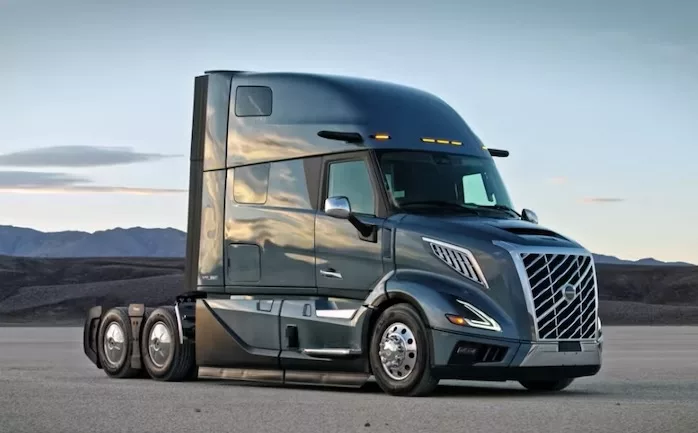Volvo Trucks North America provided a special preview to the media of its newly redesigned VNL Class 8 tractor at a ride-and-drive event held at its customer center. Attendees got a firsthand look at the truck’s exclusive active safety system, upgraded automated transmission, and various features aimed at meeting customer needs, all of which were integral in shaping the truck’s design.
The redesign incorporates a range of aerodynamic and powertrain enhancements, resulting in a significant 10% improvement in overall fuel efficiency compared to the previous model. This improvement encompasses both powertrain and aerodynamic upgrades.
Emphasizing its tailored development for the North American market, VTNA executives highlighted that this ground-up redesign will serve as the foundation for forthcoming products. These upcoming offerings include models utilizing battery-electric, fuel cell electric, and hydrogen internal combustion engines powered by renewable fuels.
“We are investing more than we ever have before in research and development,” said Magnus Koeck, vice president of marketing, strategy and brand management for VTNA, during the Feb. 13 event, where two preproduction models were made available for media. The redesign resulted in a truck where 90% of the components are different from the outgoing model.
The new @VolvoTrucksNA VNL offers a 10% overall fuel efficiency improvement over its predecessor, and features the company’s new proprietary driver assist safety system. @TransportTopics is driving pre-production versions today. pic.twitter.com/8fvVsJ0kc7
— Joe Howard (@JoeHoward_TT) February 13, 2024
“It’s not every day we do that,” Koeck said. “It’s the end of an era, but the start of a new era.”
The initial VN-series truck debuted in 1996.
Updates to the latest model include enhancements to the shifting intervals of the truck’s I-Shift automated transmission, modifications to the architecture of the D13 engine, and the integration of a 24-volt battery management system. Volvo asserts that this system reduces battery failure rates, enhances diagnostic capabilities, and facilitates an all-electric cooling system, replacing the diesel-powered auxiliary power unit.
Behind the wheel, drivers benefit from excellent forward visibility thanks to the VNL’s curved, panoramic windshield. Additionally, the truck’s wedge-shaped cab boasts improved aerodynamic efficiency compared to its predecessor, as highlighted by company executives. Bobby Compton, the product marketing manager, emphasized that the curvature of the hood and the reduced ground effects contribute to a 7% enhancement in aerodynamic performance over the previous model.
“It’s important to use the wind in your favor,” he said. Compton noted that wind flowing into the’ hood vent helps keep the engine cool.
In the new model, transmission control shifts to a column-mounted stalk, a departure from the outgoing model’s dashboard-based buttons. This stalk also doubles as the control for the truck’s engine brake, offering multiple settings for different levels of deceleration.
During test drives of both day-cab and sleeper versions of the VNL, Volvo Trucks North America representatives provided guidance to drivers on utilizing the optional Pilot Assist system. This system incorporates lane-keep assistance technology, enabling the truck to maintain its position without requiring steering wheel input while driving straight. Additionally, it can also keep the truck within its lane while navigating through a turn.
VTNA representatives emphasized that the system is not designed for hands-free operation. It will issue two alerts if the driver’s hands are not detected on the wheel. If there is still no response after these alerts, the truck’s automatic emergency braking system will bring the vehicle to a stop. Compton highlighted that this shutdown function is intended to intervene in case of a driver being incapacitated, such as during a medical emergency.
Additional optional features include lane departure warning, lane change and blind spot assistance, lane keeping and centering assistance, and dynamic steering with oversteer guidance.
The truck’s standard safety suite incorporates a feature that automatically contacts emergency services in the event of a crisis. It also boasts longer-range detection technology, which improves the recognition of smaller objects like motorcycles and pedestrians. Standard safety features include lane departure and forward collision warning systems, traction control, electronic stability control programs, and more.
Compton said, “We are committed to continue developing and building these new technologies to keep our drivers and families around those drivers safer than ever before.”
Enhancements to the powertrain, which contributed to a 3% increase in the overall 10% fuel efficiency boost, include updates to Volvo’s patented wave piston design. According to company executives, the new seven-wave design ensures more uniform heat distribution across the piston, building upon the six-wave design introduced in 2017. This alteration accompanies the implementation of a variable displacement oil pump and enhanced insulation in the engine’s turbo compounding unit, as stated by VTNA.
Chris Stadler, the product marketing manager, specified that the D13 engine available in the new VNL will offer horsepower ratings ranging from 405 to 500 and torque ratings from 1,750 to 1,950 pound-feet. Additionally, the truck will be available in four trim packages: Core, Edge, Edge Black, and Ultimate.
Stadler further noted that options will be bundled similarly to how they are in passenger vehicles. While customers will have the opportunity to select individual options, the packages are designed to offer pricing advantages while also allowing buyers to experience new technologies.





